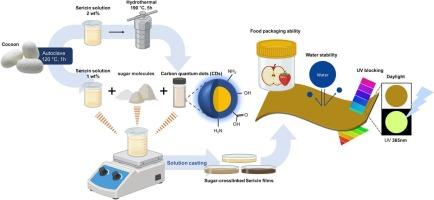Sustainable bioactive films from sericin and carbon quantum dots: A green approach to smart food packaging
IF 5.1
3区 工程技术
Q1 CHEMISTRY, APPLIED
引用次数: 0
Abstract
The increasing environmental burden of petroleum-based plastics has strengthened the demand for sustainable, biodegradable, and multifunctional materials in the food packaging industry. In this study, we developed a novel biologically active film by combining fructose-mediated Maillard crosslinking and sericin-derived carbon quantum dots (S-CQDs) within a sericin matrix. The Maillard reaction strengthened the film structure through covalent bonding and producing antioxidant melanoidin compounds. S-CQDs synthesized via a green hydrothermal route contributed additional functions such as enhanced mechanical strength, radical scavenging activity, and water barrier performance. The resulting composite films significantly improved tensile strength, elongation, ultraviolet protection, and water resistance compared to pure sericin films. The Fru/C exhibited excellent antioxidant activity in both DPPH and ABTS assays, and the highest preservation performance among the examined films when applied to fresh fruits, effectively minimizing weight loss and visual spoilage. These results demonstrated a synergistic strategy to convert silk industry byproducts into multifunctional packaging films through environmentally friendly processes, providing a promising platform for next-generation sustainable food packaging.

丝胶和碳量子点的可持续生物活性薄膜:智能食品包装的绿色途径
石油基塑料日益增加的环境负担加强了食品包装行业对可持续、可生物降解和多功能材料的需求。在这项研究中,我们将果糖介导的美拉德交联和丝胶衍生的碳量子点(S-CQDs)结合在丝胶基质中,开发了一种新的生物活性膜。美拉德反应通过共价键强化膜结构,生成抗氧化类黑素化合物。通过绿色热液途径合成的S-CQDs具有增强的机械强度、自由基清除活性和水屏障性能等附加功能。与纯丝胶膜相比,所得复合膜的抗拉强度、伸长率、紫外线防护和耐水性显著提高。在DPPH和ABTS实验中,Fru/C均表现出优异的抗氧化活性,在应用于新鲜水果时,Fru/C的保鲜性能最高,有效地减少了水果的重量损失和视觉腐败。这些结果证明了通过环保工艺将丝绸工业副产品转化为多功能包装薄膜的协同策略,为下一代可持续食品包装提供了一个有前途的平台。
本文章由计算机程序翻译,如有差异,请以英文原文为准。
求助全文
约1分钟内获得全文
求助全文
来源期刊

Reactive & Functional Polymers
工程技术-高分子科学
CiteScore
8.90
自引率
5.90%
发文量
259
审稿时长
27 days
期刊介绍:
Reactive & Functional Polymers provides a forum to disseminate original ideas, concepts and developments in the science and technology of polymers with functional groups, which impart specific chemical reactivity or physical, chemical, structural, biological, and pharmacological functionality. The scope covers organic polymers, acting for instance as reagents, catalysts, templates, ion-exchangers, selective sorbents, chelating or antimicrobial agents, drug carriers, sensors, membranes, and hydrogels. This also includes reactive cross-linkable prepolymers and high-performance thermosetting polymers, natural or degradable polymers, conducting polymers, and porous polymers.
Original research articles must contain thorough molecular and material characterization data on synthesis of the above polymers in combination with their applications. Applications include but are not limited to catalysis, water or effluent treatment, separations and recovery, electronics and information storage, energy conversion, encapsulation, or adhesion.
 求助内容:
求助内容: 应助结果提醒方式:
应助结果提醒方式:


